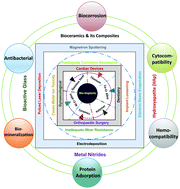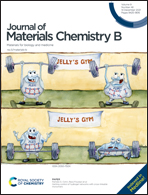Surface functionalized bioceramics coated on metallic implants for biomedical and anticorrosion performance – a review
Abstract
In modern days, the usage of trauma fixation devices has significantly increased due to sports injury, age-related issues, accidents, and revision surgery purposes. Numerous materials such as stainless steel, titanium, Co–Cr alloy, polymers, and ceramics have been used to replace the missing or defective parts of the human body. After implantation, body fluids (Na+, K+, and Cl−), protein, and blood cells interact with the surface of metallic implants, which favours the release of ions from the metallic surface to surrounding body tissues, leading to a hypersensitive reaction. Body pH, temperature, and interaction of immune cells also cause metal ion leaching and lose host cell interaction and effective mineralization for better durability. Moreover, microbial invasion is another important crisis, which produces extracellular compounds onto the biomaterial surface through which it escapes from the antimicrobial agents. To enhance the performance of materials by improving mechanical, corrosion resistance, antimicrobial, and biocompatibility properties, surface modification is a prerequisite method in which chemical vapour deposition (CVD), physical vapour deposition (PVD), sol–gel method, and electrochemical deposition are generally involved. The properties of bioceramics such as chemical inertness, bioactivity, biocompatibility, and corrosion protection make them most suitable for the surface functionalization of metallic implants. To the best of our knowledge, very limited literature is available to discuss the interaction of body proteins, pH, and temperature onto bioceramic coatings. Hence, the present review focuses on the corrosion behaviour of different ceramic composite coating materials with different conditions. This review initially briefs the properties and surface chemistry of metal implants and the need for surface modifications by different deposition techniques. Further, mechanical, cytotoxicity, antimicrobial property, and electrochemical behaviour of ceramics and metal nitride coatings are discussed. Finally, future perspectives of coatings are outlined for biomedical applications.



 Please wait while we load your content...
Please wait while we load your content...